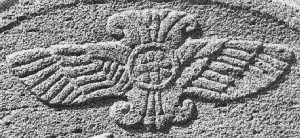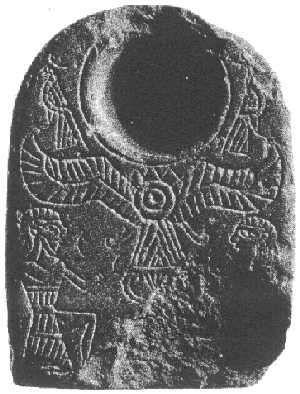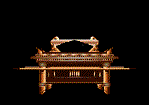LMLK Home
Biblical Accounts
NonBiblical Accounts
Theories
HBRN
MMST
SUKE
ZYF
Generic
x (cannot classify)
2-Top
2-Divided
2-Undivided
4-Cursory
4-Lapidarist
Jars
Personal Seals
Incisions
Paleography
Typologies
Corpus
Stratigraphy
Geography
Displays
Publications
Credits
Updates

|
". . . Certain stamped jar-handles have been discovered which have given rise to a good deal of controversy."----Macalister in PEQ, July 1905
- MILITARY ACTIVITY
- Assyrian Campaigns
- Sennacherib led two campaigns through Judah, one when he withdrew voluntarily after receiving a tribute payment, & a later one (after returning to Nineveh for a while) when the majority of his army was destroyed by an act of God (& naturally, this would not be recorded in Assyrian records).
- Sennacherib led only one campaign through Judah by interpreting the Biblical accounts as being in conflict (i.e., either he withdrew voluntarily after receiving a tribute payment, or the majority of his army was destroyed by an act of God), & also due to no specific mention of a second campaign in any ancient documents.
- Sennacherib led only one campaign through Judah (as told by Josephus) & even though Hezekiah paid a tribute to him, Sennacherib attacked anyway & the majority of his army was destroyed by an act of God or otherwise (as told by Berosus).
- Egyptian Alliance
- King Hezekiah's alliance with Tirhaka occurred while Tirhaka was a military leader (or prince) before becoming king.
- Tirhaka was already king at the time of the alliance.
- CHRONOLOGY
- Co-regencies:
- Tirhaka reigned with one of his brothers.
- King Hezekiah co-reigned with his son, Manasseh, for 10 years.
- In the northern kingdom of Israel, Pekah's reign overlapped the reigns of Menahem & Pekahiah (2Kings 15:17-31).
- King Hezekiah co-reigned with his father, Ahaz, for 10 years.
- Conventional Dates:
Please note that these dates are + or - one year, which doesn't interfere with the theories since the most significant controversies are over periods of 12 & 20 years.
- The Iron Age began around 1200 BC.
- Shalmaneser (5th) began to attack Samaria around 723-722 BC.
- Sargon (2nd) conquered Samaria around 721-720 BC.
- Sargon (2nd) conquered Ashdod around 714 BC.
- Sargon (2nd) died around 705 BC.
- Sennacherib reigned from 705-681 BC, but his annals only cover the period 705-689 BC.
- Hezekiah reigned from 727-686 BC (41 years).
- Hezekiah reigned from 727-698 BC (29 years).
- Hezekiah reigned from 715-686 BC (29 years).
- Sennacherib conquered Lachish around 701 BC.
- Sennacherib's third campaign (including the conquest of Lachish) was recorded on the Rassam cylinder around 700 BC.
- Sennacherib's palace in Nineveh (including the Lachish frieze) was completed around 694 BC.
- Tirhaka became king of Ethiopia & Egypt around 690 BC.
- Sennacherib conquered Babylon around 689 BC.
- Tirhaka claimed a military victory against an unnamed opponent before a significant flood of the Nile around 685-684 BC on his stela.
- Nebuchadnezzar conquered Jerusalem around 586 BC.
- LMLK Period of Use, Beginning (terminus a quo):
- During the reign of Uzziah per 2Chronicles 26:9-10 (vineyards)
- Near the end of the reign of Ahaz when Judah became an Assyrian vassal.
- At the beginning of the reign of Hezekiah in response to worship reformation per 2Chronicles 31:4-20
- During the reign of Hezekiah in preparation (i.e., military supplies build-up) for Assyrian attacks after the death of Sargon (2nd) per 2Kings 18:7 (rebellion against Assyria) & 2Chronicles 32:28-29 (storehouses & cities)
- LMLK Period of Use, Ending (terminus ad quem):
- During the reign of Hezekiah following the conquest of Lachish by Sennacherib (one-campaign theory)
- During the reign of Hezekiah following Sennacherib's final departure from Jerusalem (two-campaign theory)
- At the conclusion of Hezekiah's reign, when Manasseh began to reign
- During the reign of Manasseh when he was temporarily taken to Babylon
- During the reformation of Josiah
- When the rosette seals were instituted (i.e., during Josiah or Jehoiakim's reigns)
- During the reign of Zedekiah with the conquest of Jerusalem by Nebuchadnezzar
- CIRCLES
- Indicated that the volume of the jar was accurate after firing
- Indicated that the volume of the jar was inaccurate after firing
- Indicated a cancellation of the LMLK &/or Personal stamps so that the jar's contents could be used for other purposes or by other people (for example, private citizens instead of priests, priests instead of military personnel, etc.)
- Indicated that the jar had been received or paid for
- Indicated the age of the wine
- Indicated "royalty" to Assyrians
Note: Concentric circles along with rosettes indicate royal possessions on Sennacherib's Lachish frieze (this greatly magnified photo shows one of many on his outer garment covering his lower legs; the whole photo can be seen on the Geography page):

- Indicated a memorial of the angelic massacre (possibly symbolizing a divine vehicle similar to that described by Ezekiel as a "wheel within a wheel")
- Indicated the official symbol of King Manasseh
- CITIES
- Fortified Cities of Judah (2Chronicles 11; refer to Aharoni's fortresses map):
- Established by Rehoboam as stated
- Established by Hezekiah
- Established by Josiah
- MMST:
- Slang for Jerusalem based on the word mmsLt
- Town edited from the Masoretic text (but possibly one preserved by the Septuagint (Joshua 15:60)) in the district of Bethlehem (i.e., the territory between Jerusalem & Hebron)
- Biblically-unnamed town near the provincial center at Mizpah (Joshua 15:38)
- Mampsis (meaning "place where one stops in the evening"), or Mamshit (i.e., Kurnub), which has been identified with a small village about 25 miles (40km) southeast of Beersheba
- Eshtemoa based on phonic resemblance & being located in the vicinity of Hebron, Socoh, & Ziph
- Mareshah based on phonic resemblance & being included in the 2Chronicles 11 list of fortified cities with stores (i.e., jars) along with Hebron, Socoh, & Ziph
- Emmaus ('Amwas near Latrun) in the region between Gezer, Zorah, & Ajalon
- Biblically-unnamed town at modern Tell el-Meshash (Tel Masos)
- Biblically-unnamed town at modern Tell 'Ira (Horvat el-Garra)
- Biblically-unnamed designation for Ramet Rahel
- Biblically-unnamed royal estate in the Rephaim Valley (Emeq Rephaim)
- Shokoh: Joshua 15 lists two locations with this name; the one on the seals may refer to either the Sochoh of verse 35 (northwest of Hebron) or 48 (southwest of Hebron) depending on the extent of the royal dominion at the time &/or seal purpose:
- northern if limited dominion
- northern or southern if extended dominion
- northern or southern if potteries
- southern if vineyards
- Ziph: Joshua 15 lists two locations with this name; the one on the seals may refer to either the Ziph of verse 24 (far from Hebron) or 55 (close to Hebron) depending on the extent of the royal dominion at the time &/or seal purpose:
- close if limited dominion, potteries, or vineyards
- close or far if extended dominion
- JARS, LMLK
- Contents, Pithos
- Grain
- Oil
- Wine
Note: Carbonized grain has been found in some ancient storage jars, but so far none has been found in LMLK jars; no chemical analysis has been performed to search for traces of oil/wine solid particles in LMLK pottery.
- Contents, Type 484
- Grain
- Oil
- Wine
Note: Some lids excavated with Type 484 jars were pierced to allow carbon dioxide to escape during fermentation if the contents were wine; however, some lids were made by placing a large leaf over the opening & then covering with mud, which formed an airtight seal when it dried (impressions of the leaves are visible on some examples); other stoppers were of a removable/reusable type (as seen on Jar 10091).
- Composition/Construction
- Indicates different manufacturing sites
- Indicates different periods of manufacture
- Indicates different potters
Note: Chemical analyses of LMLK jars indicate that Type 484 jars were manufactured with clay from a single location or limited to the Shephelah region; clay of pithoi jars can be identified with the Jerusalem region.
- Purpose
- Military build-up
- Levitical provisions
- Government supplies
- Assyrian tribute revenue/taxes
- SCRIPTS
- Different forms of paleo-Hebrew script in the impressions indicates different seal engravers.
- Different forms of paleo-Hebrew script in the impressions indicates different periods of use (e.g., the reigns of Uzziah, Hezekiah, Manasseh, & Josiah).
- SEALS, LMLK
- Function:
- Accuracy of volume; however, no other class of Judean jars are known to have had such a guarantee & their actual volume was not consistent
- Quality of the jars' contents (e.g., aged, smoked, colored)
- Taxation (e.g., 1 out of every 10 jars was stamped)
- Location where the contents came from (which was, & still is, the common practice for wine jars although the G2T type specifies no location)
- Location where the contents were sent to (although the G2T type specifies no location)
- Icon, 2-winged:
Note that the central element of the 2-winged icon was in fact a ball/globe/orb/sphere--not simply a flat disk as most scholars have assumed based on weak stamps!!! Sub-theories .4 & .8 remain here for archival purposes.
- Emblem of the southern kingdom of Judah since a majority of them were excavated around Jerusalem & personal seals have only been found on jars with 2-winged icons
- Depicts a bird (dove or eagle); the almost-parallel lines are feathers
- Depicts the sun 2-dimensionally as a flat disk (the 3-dimensional representation was a coincidence of the engraving tool); the almost-parallel lines are rays
- Depicts a plumed rosette as seen in this photo (from "The Ancient Near East in Pictures Relating to the Old Testament" [#630]) of a contemporary (8th-century B.C.) neo-Hittite funeral stela:
 Note: Rosettes are generally agreed to have been stamped on Judean jars after LMLK stamps had been discontinued.
Note: Rosettes are generally agreed to have been stamped on Judean jars after LMLK stamps had been discontinued.
- Depicts a flying scroll sealed with a bulla.
- Indicates vassalship to Assyria
- Indicates alliance with Babylon against Assyria
- Depicts winged concentric circles as seen in this photo (from Eretz-Israel vol. 18) of a contemporary (8th/7th-century B.C.) Phoenician/Palestinian stone vessel:

- Depicts a scarab's dung ball (as seen being carried in one of King Hezekiah's personal seals)
- Depicts the sun 3-dimensionally as a globe similar to the one in this drawing of a 26-inch Phoenician marble column found in 1852 at Tyre (from "History of Art in Phoenicia & Its Dependencies vol. 1" by Georges Perrot & Charles Chipiez):
 (click to see whole column) (click to see whole column)
- Depicts an abstract power or invisible force such as the glory of God:

- Depicts the shining face of God per Numbers 6:25, Psalms 31:16, 67:1, 80:3,7,19, 119:135, Daniel 9:17
- Icon, 4-winged:
- Emblem of the northern kingdom of Israel since impressions with 4-winged icons have been excavated in Samaria
- Emblem of the southern kingdom of Judah since impressions with 4-winged icons have been excavated in Samaria that may have been sent from there
- Emblem of the southern kingdom of Judah since Hezekiah's personal seal also featured a scarab/beetle
- Emblem of Egypt used during a period of alliance
Note: Most of the skulls excavated from Lachish are characteristic of Egyptians.
- Represented a cherub (etymologically close to "scarab") like those that may have decorated Solomon's Temple & covered the Ark
- Icons (Both Major Types)
- Used to promote unity between the northern kingdom of Israel & southern kingdom of Judah since a remnant of people from the north took refuge in the south
- Used to symbolize alliance between Judah & Egypt
- Logos for potteries (2-winged in northeastern Judah; 4-winged in southwestern Judah
- Emblems that would be interpreted by illiterate people as "belonging to the king"
- Designated two grades of wine
- Designated two different contents (e.g., oil vs. wine)
- Symbolized quality of God (i.e., protective/sheltering wings per Ruth 2:12, Psalms 17:8, 36:7, 57:1, 61:4, 63:7, 91:4; healing/resurrection per Malachi 4:2)
- Inscriptions may refer to one or possibly a combination of the following:
Note: Depending on the context of the theory, the inscriptions may be read from top to bottom (e.g., "To the King; Hebron") or from bottom to top (e.g., "Alliance of the King").
- contents for the king
- contents for military consumption
- contents from the king
- contents approved by the king's royal standards (i.e., an abbreviation of "BT LMLK" [royal bath])
- specific towns possibly referenced in the Bible:
Hezekiah ... made ... storehouses for the harvest of grain, wine, & oil; & ... provided cities for himself.--2Chronicles 32:27-29
- regions: The South (Negeb/Negev)--ZYF, The Lowland (Shephelah)--SUKE, The Hills/Mountains--HBRN, & The Wilderness/Desert--MMST
- regions: The South (Negeb/Negev)--MMST, The Lowland (Shephelah)--SUKE, The Hills/Mountains--HBRN, & The Wilderness/Desert--ZYF
- tax/tithe-collecting administrative centers that received products to be distributed throughout the kingdom (refer to Welten's distribution maps)
- agricultural centers that produced products to be distributed throughout the kingdom
- supply centers that stored products in general military zones/districts (refer to Aharoni's districts map)
- specific vineyards
- wine-producing centers
- official weight/measurement centers
- individual potters
- potteries (family names) possibly referenced in the Bible (1Chronicles 4):
16_The sons of Jehallelel were Ziph, Ziphah, Tiria, and Asarel. 17_The sons of Ezrah were Jether, Mered, Epher, and Jalon. And Mered's wife bore Miriam, Shammai, and Ishbah the father of Eshtemoa. 18_(His wife Jehudijah bore Jered the father of Gedor, Heber the father of Sochoh, and Jekuthiel the father of Zanoah.) And these were the sons of Bithiah the daughter of Pharaoh, whom Mered took. 19_The sons of Hodiah's wife, the sister of Naham, were the fathers of Keilah the Garmite and of Eshtemoa the Maachathite ... 21_The sons of Shelah the son of Judah were Er the father of Lecah, Laadah the father of Mareshah, and the families of the house of the linen workers of the house of Ashbea ... 23_These were the potters & those who dwell at Netaim & Gederah; there they dwelt with the king for his work.
- potteries (geographical names)
- government mottoes/slogans (e.g., HBRN="society", MMST="responsibility", SUKE="protection", ZYF="supply")
- military designations/purposes (e.g., HBRN="alliance", MMST="force", SUKE="defense", ZYF="battlement")
- the Ammonite deity (not the Judean king)
- YEVE (a.k.a. Yahweh, Jehovah, The LORD per Psalms 10:16, 29:10, 93:1 & Zechariah 14:9)
- years (i.e., a different inscription for each year)
- seasons/calendrical periods (i.e., a different inscription for each time of the year)
- votive dedications (e.g., HBRN="congregation", MMST="property", SUKE="sanctuary", ZYF="mouthful")
- valley collection-centers (Hebron = Lachish Valley, MMST = Ajalon Valley, Sokoh = Elah Valley, Ziph = Sorek Valley; suggested by Michael Welch in February, 2007, but not formally published yet)
- SEALS, PERSONAL
- Belonged to potters
- Belonged to private officials (not in royal service) such as land grant recipients or their administrators
- Belonged to royal officials
- Belonged to priests &/or Levites (2Chronicles 31)

And Hezekiah gave encouragement to all the Levites who taught the good knowledge of the LORD.--2Chronicles 30:22
|






